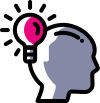PART A: CLASS ACTIVITY
What is the chance to get a 1 when rolling a six-sided die? What would you expect? Predict the outcome.
The chance of rolling a 1 is ______ out of ______.
Roll your die at least 18 times and list all the outcomes in this tally chart:
Did these results match your prediction?
Write a sentence to say why or why not.
Now use these results to calculate the probability of throwing a number:
Are there any links between these probabilities? Why?
Part B: The Investigation
Your investigation will involve rolling two six-sided dice and recording the results. You will use these results to investigate an outcome.
Complete the table below to list the possible outcomes (total of both dice) when throwing two six-sided dice.
Using your sample space above as a guide, investigate an outcome. You can choose from the examples below or choose one of your own. You will need to decide how many times to roll the dice (the sample size) and how to set up your frequency tables.
Examples of outcomes that you could investigate:
What is the probability that the sum of the numbers thrown on each dice are:
a) even
b) odd
c) greater than 10
d) less than 7
The outcome I am going to investigate is:
I am going to roll the dice ________ times.
This is enough for this experiment because:
My frequency table:
The report:
Introduction – provide an overview of your investigation
• What is your aim?
• What is your prediction? Justify this prediction mathematically.
Instructions – step by step instructions of how to conduct your investigation
• You must create a set of written or typed instructions.
o Setup, steps you will follow, what you will record
o Clear, concise, simple language, well structured
Description – what do you need to conduct the investigation?
• Provide all the materials needed for the investigation
o Have a list of equipment for organisation purposes
o Clearly labelled frequency tables for recording of results
Probability Analysis - (the most important bit of the whole investigation!)
• Discuss the probabilities that are involved
• Remember to reference sample space, favourable outcomes
o Sample space refers to all of the possible outcomes from an experiment
o In probability, an experiment is a repeatable process with different possible outcomes
• Are the events equally likely or not equally likely?
• Don’t forget to assign probabilities to the outcomes of your events in your sample space!
o Each unique outcome needs to have a listed probability
Conclusion – What worked well? Even better if? What would you change? Why?
Students succeed in their courses by connecting and communicating with an expert until they receive help on their questions

Consult our trusted tutors.